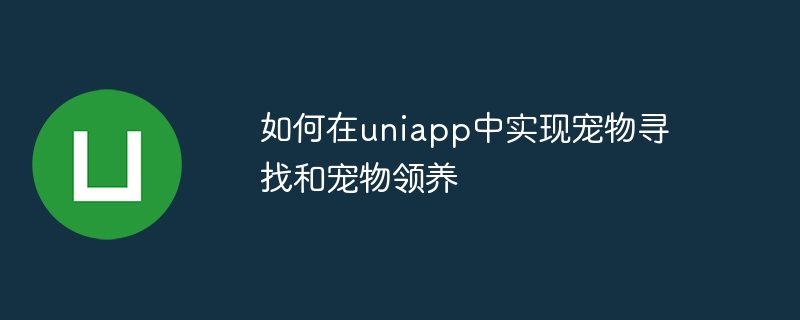Home >Web Front-end >uni-app >How to implement pet search and pet adoption in uniapp
How to implement pet search and pet adoption in uniapp
- 王林Original
- 2023-10-18 11:03:431360browse

How to implement pet finding and pet adoption in uniapp
As people's love and attention for pets continue to increase, pet finding and pet adoption have become a hot topic topic. Although there is a certain complexity in implementing pet search and pet adoption in Uniapp, as long as we follow certain steps and use appropriate code examples, I believe we can easily achieve the goal.
First of all, to implement pet search and pet adoption in Uniapp, we need a pet search function page and a pet adoption function page. You can realize the function of displaying pet information by using components in the page, such as list, card, etc.
To implement the pet search function page, first we need to obtain pet information from the background, including pet pictures, pet descriptions, pet types, etc. We can use the uni.request function to send a request to the background to obtain data. The following is a simple sample code:
// 宠物寻找功能页面
<template>
<view>
<list>
<cell v-for="pet in pets" :key="pet.id">
<image :src="pet.image"></image>
<view>{{ pet.name }}</view>
<view>{{ pet.type }}</view>
</cell>
</list>
</view>
</template>
<script>
export default {
data() {
return {
pets: []
}
},
mounted() {
this.getPets()
},
methods: {
getPets() {
uni.request({
url: '后台接口地址',
success: (res) => {
this.pets = res.data.pets
}
})
}
}
}
</script>To implement the pet adoption function page, we need to create a form in the page where users can fill in adoption information, such as name, contact information, etc. At the same time, we also need to submit the information filled in by the user to the backend for subsequent processing. The following is a simple sample code:
// 宠物领养功能页面
<template>
<view>
<form>
<view>姓名:</view>
<input v-model="name"></input>
<view>联系方式:</view>
<input v-model="contact"></input>
<button @click="adopt">提交</button>
</form>
</view>
</template>
<script>
export default {
data() {
return {
name: '',
contact: ''
}
},
methods: {
adopt() {
uni.request({
url: '后台接口地址',
data: {
name: this.name,
contact: this.contact
},
success: (res) => {
if (res.data.code === 200) {
uni.showToast({
title: '领养成功'
})
} else {
uni.showToast({
title: '领养失败'
})
}
}
})
}
}
}
</script>The above is only a simple example of the pet search and pet adoption functions, and the specific implementation needs to be adjusted according to the actual situation. In addition, corresponding interfaces need to be developed in the background for obtaining pet information and submitting pet adoption information.
I hope the above sample code can be helpful to you to implement pet search and pet adoption in Uniapp. I wish you success!
The above is the detailed content of How to implement pet search and pet adoption in uniapp. For more information, please follow other related articles on the PHP Chinese website!

